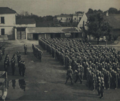Slovak invasion of Poland
The Slovak invasion of Poland occurred during Nazi Germany's invasion of Poland in September 1939. The recently created Slovak Republic joined the attack, and Field Army Bernolák contributed over 50,000 soldiers in three divisions.[1][2] Since most of the Polish forces were engaged with the German armies, which were more to the north of the southern border, the Slovak invasion met only weak resistance and suffered minimal losses.
The Bernolák army group was led by Slovak Defence Minister Ferdinand Čatloš and had its initial headquarters in Spišská Nová Ves, though after September 8 this was moved to Solivar near Prešov. It consisted of:
The group was part of the German Army Group South; was subordinated to the 14th Army, led by Wilhelm List; and contributed to the 14th Army's total of five infantry divisions, three mountain divisions, two panzer divisions and one Luftwaffe division. Bernolák's tasks were to prevent a Polish incursion into Slovakia and to support German troops.
They were opposed by the Polish Carpathian Army, which consisted mainly of infantry units with some light artillery support and no tanks.
Campaign[edit]
The attack started without a formal declaration of war on September 1, 1939, at 5:00 a.m. The 1st division occupied the village of Javorina and the town of Zakopane and continued toward Nowy Targ to protect the German 2nd Mountain Division from the left.[3]: 50 On September 4 and 5, it engaged in fighting with regular Polish Army units. On September 7, the division stopped its advance 30 km inside Polish territory. Later, the division was pulled back, with one battalion remaining until September 29 to occupy Zakopane, Jurgów and Javorina.
The 2nd Division was kept in reserve and participated only in mopping-up operations in which was supported by the Kalinčiak group. The 3rd Division had to protect 170 km of the Slovak border between Stará Ľubovňa and the border with Hungary. It fought minor skirmishes, and after several days, it moved into Polish territory and ended its advance on September 11.
Two or three Slovak air squadrons (codenamed Ľalia, Lily) were used for reconnaissance, bombing and close support for German fighters. Two Slovak planes were lost (one to anti-aircraft fire, another to an accidental crash), and one Polish plane was shot down. The total Slovak losses during the campaign were 37 dead, 114 wounded and 11 missing.
Aftermath[edit]
All Slovak units were pulled back until the end of September 1939. On October 5, a victorious military parade was held in Poprad. The mobilised units were gradually demobilised, and the Army Group Bernolák was disbanded on October 7.
The Slovak Army took around 1,350 civilian prisoners in Poland. In February 1940, around 1,200 of them were handed to Germans and some of the remainders to the Soviets. The rest were kept in a Slovak prison camp in Lešť.
All of the disputed territory, whether in Poland from 1920 or only from 1938, was given to Slovakia, which was confirmed by a Slovak parliamentary resolution on December 22, 1939. That arrangement lasted until 20 May 1945, when the border line was returned to its 1920 position. Since the war was started without a formal declaration of war and there were no longer any Polish prisoners of war held by Slovakia, there was no formal peace treaty between Poland and Slovakia.




